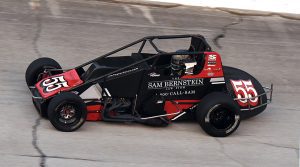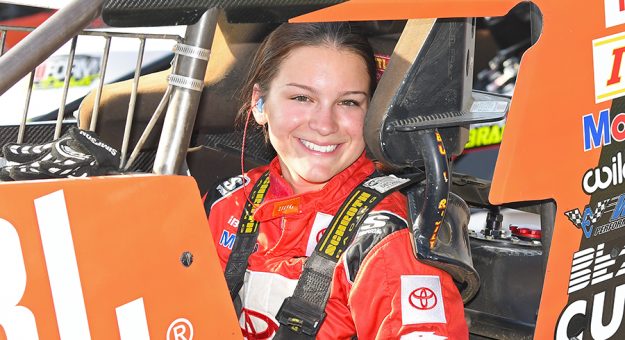Over the past year, the dirt-track ranks have witnessed a thunderstorm of talented female racers finding success.
Numerous racers have contributed to the surge, moving past milestones and setting national records at a quickening pace. With the new racing season at hand, it wouldn’t come as a surprise to see the trend continue. But does this recent progress beckon a new era for motorsports, where the slow trickle of talent becomes a sea of trophies for female racers?
Looking at the books, the flood appears to have been triggered a year ago.
In January 2022, Kaylee Bryson made history as the first woman to qualify for the finale of the Lucas Oil Chili Bowl Nationals. In May, Taylor Ferns became the first woman to stand on a USAC Silver Crown podium with a third-place finish. Later that month, Taylor Reimer was deemed the first woman to win a national midget feature with her victory in Xtreme Outlaw Midget Series competition.
During the summer, there were five women racing semi-regularly in the USAC NOS Energy Drink National Midget Championship — including Bryson, Reimer, Mariah Ede, Maria Cofer and Jade Avedisian.
In January, Avedisian became the first woman in Chili Bowl history to earn the event’s rookie-of-the-year award. Furthermore, both she and Bryson qualified for the Saturday night feature, which was also an event record. Despite the breakthroughs, the accomplishments often seem dampened when they’re attached to the words “female race car driver.”
“I win races, I run up front, I’ve done a lot of stuff that not even a lot of male racers can say they’ve done,” Ferns said. “But I just feel like when they say ‘female’ race car driver … I’m almost like in my own little lane.”
The 26-year-old has compiled an impressive list of on-track credentials over the course of her career, but the recognition for what she’s done as a driver has fallen a bit flat.
In 2009, 13-year-old Ferns was tied for the title of “Winningest Female in USAC History.” She finished in the top 10 during her first CRA Late Model, USAC Silver Crown and ARCA Menards Series races in 2012 and ’13. Ferns also earned several sprint car victories in 2021.

In a picture-perfect world, she’d like to see the “female” label dropped so she can simply be referred to as a “race car driver” like her competition and purely be known for her skills behind the wheel.
“I’ve gone through a handful of different decades of this now,” Ferns said. “When I was younger, there definitely weren’t as many females in motorsports as there are now, but I still find myself, within certain divisions, being the only female.”
Ferns feels as if the emphasis on her performances behind the first “insert here” finish for a female only serves to separate her from her fellow drivers. However, she acknowledges that it’s not necessarily the media’s fault for using the label.
“Really, the reason why we’re still hearing that is because there hasn’t been a girl to do it before,” Ferns explained.
Cofer goes back and forth when it comes to categorizing podium finishes as “female” records.
“I think it’s definitely notable when females are the ‘first’ to do those things, but at the same time, it’s kind of just like a standard. Like, you’re a racer, you should be getting quick times,” Cofer said. “It’s strange sometimes, when the media blows it so out of the water.”
Though she retired from racing last October due to a lingering injury, Cofer’s name will forever be imprinted in the USAC record books. In September, she and her father, Johnny Cofer, became the second father-daughter duo to earn the fast-qualifier award at a national midget race.
The 23-year-old believes the best solution is simply for women to keep doing what they’ve been doing. Eventually, all the “firsts” will be accomplished and it won’t be nearly as much of a spectacle — especially with drivers like Bryson hunting down wins.
Bryson has been sharpening her teeth in her home state of Oklahoma since she made her NOW 600 Micro Series debut in 2013. Her career as a midget driver largely began in 2018 with her first Chili Bowl entry and from that point, she has continued to make waves in USAC’s national midget championship.
In contrast to Ferns, Bryson has had less time to experience the growing pains of the industry, but the 21-year-old understands the presence of women in the pits has been increasing.
“From a young age, I would always go to the races, and I never saw a whole lot of girls racing,” Bryson said. “Now that I’m getting older and I’m racing, I’m starting to see more and more women come into motorsports and it’s a great feeling.”
Bryson will be showing a wheel in several different disciplines this season, as she plans to join Ferns full time in the Silver Crown ranks, maintain a presence in midget and sprint car racing, and venture into the Trans-Am TA2 series with the Sam Pierce Racing team. For Bryson, the fact that she’s one of the only females on the track is an afterthought.
“When you put on your helmet, you’re just a driver and at the end of the day, you want to drive as fast and hard as you can go, whether you’re a female or a male,” Bryson said. With a surplus of teams looking to create diverse rosters these days, Bryson believes there are ample opportunities for female drivers to move up the racing ladder.
“I’m going to take any opportunity I can, but from a young age, I was like, ‘Man, I want to make it to NASCAR,’” Bryson said. “But I think as long as I’m driving something, I’m going to be happy.”
In regard to sponsorship, being the only female in a male-dominated industry has proven to be an advantage in some cases.

“It opened a lot of doors for me on the marketing side of it,” Cofer commented. “Maybe if I wasn’t a female, who’s to say if I would’ve gotten those sponsorships or not, but I think it was beneficial.”
Ferns agrees to a certain degree, but she’s become meticulous with her sponsorship pitches — focusing more on her results than her persona as a female in the industry.
“You can sell yourself as being a female within that division, but at some point, people are going to get tired of the gimmicks. You have to have the on-track results,” Ferns said. “People might say girls have a level up, but it’s just all on how you present yourself.”
Beginning with the introduction when she walks in the board room or enters a Zoom call with potential sponsors, Ferns introduces herself as a race car driver, a podium-finisher and a winner. Her gender comes secondary to her accomplishments.
Former Indy car driver Lyn St. James echoed Ferns’ attitude, divulging the three keys to sponsorship she shares with the young women she mentors in the motorsports community — race results, brand image and exposure.
As one of the most successful women in the history of motorsports with seven Indianapolis 500 starts and numerous other accolades, St. James has been acquiring wisdom on how to successfully maneuver through the male-dominated industry since her on-track debut in the Sports Car Club of America in 1973.
Many of the issues that female drivers face today, St. James experienced decades ago.
“I remember when I would finish third in the Kelly American Challenge, sometimes I got more press than the person who won. But it was because this was back in the ’70s when it was unique,” St. James said when asked about how she was approached by journalists in her heyday as the only woman on the sports car grid.
Simply put, she said, “The media need to get over it.”
However, the forward progress St. James has witnessed in the past five years has her invigorated for the future that lies ahead for women in motorsports.
“I see a movement happening and there’s horsepower behind it,” St. James said.
But can the NASCAR dreams of dirt-track stars like Bryson become reality?
Find out next month in Part II.
This story appeared in the March 15, 2023, edition of the SPEED SPORT Insider.

